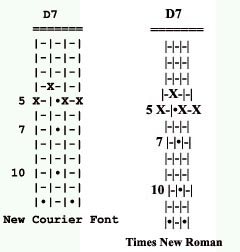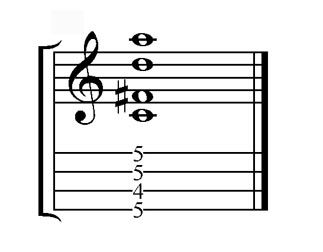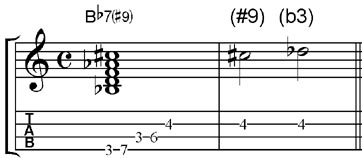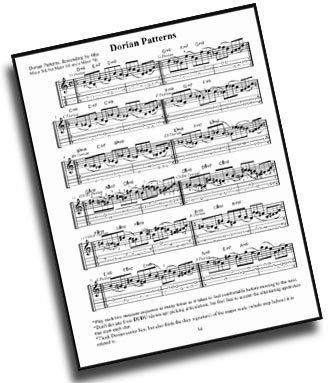« February 2010 |
Main
| April 2010 »
 March 25, 2010 | Sharing chords
March 25, 2010 | Sharing chords
It happens. Once in a while you find that magic chord in your fingers, and you don't want to lose it in your head. It never hurts to have some way to document it and retrieve it later. You might even want to share it online or email it to a friend.
You can use standard notation; demographically, not that many players are able to read chords immediately, especially more than one note at a time. Some struggle with simple monophonic melodic lines as it is, and in the world of notation you have to include potentially irrelevant definitions like note value and articulation. As strong advocates of standard notation skills, we're not suggesting this is useless information, just in this context we want to be able to show fingerings on the fretboard.
One simple way is to indicate the fret number starting on the G string. A D7 might be 5 4 5 5. This is pretty quick, but takes some getting used to because it's not particularly graphical. On the MandolinCafe.com website, a clever use of ASCII characters yields a pattern very easy to read: MandolinCafe ASCII Chord Library.
Word of caution here--you have to use a font like "courier" or the spacing gets jumbled.

In the publishing world, the preference is to do both standard notation and TAB, and in the course of a song or passage of music, this would be the best way to reach the masses. Of course a good software programs is essential for this:

For your own practical purposes, we suggest using our handy JazzMando fretboard template. Print several of these pages off with your computer and keep them handy, maybe fold one sheet in half or quarter and leave it in your case for when the muse strikes. You don't want to forget that cool chord discovery! Plus, the price is right--FREE!
Print: Jazzmando Chord Template
 As a side note, in the past we used to indicate finger numbers on our fretboard diagrams. This ended a couple summers ago when we noticed in one of his workshops, master clinician and jazz mandolinist, Paul Glasse using a different approach to the same chord. Some will use a combination of barre (double stop) chords, but Paul tended to spread his long thin fingers out and cover the separate chord members with individual fingers. Rather than dictate which finger, which string, we now opt to leave the method of fingering up to the reader, with just a solid circle block. You might want to block your own chords with a black circle, or indicate your own fingering preference. Everybody's fingers are unique in shape, size, and flexibility, however, and you might be surprised at how differently chords are approached by individual professionals. As a side note, in the past we used to indicate finger numbers on our fretboard diagrams. This ended a couple summers ago when we noticed in one of his workshops, master clinician and jazz mandolinist, Paul Glasse using a different approach to the same chord. Some will use a combination of barre (double stop) chords, but Paul tended to spread his long thin fingers out and cover the separate chord members with individual fingers. Rather than dictate which finger, which string, we now opt to leave the method of fingering up to the reader, with just a solid circle block. You might want to block your own chords with a black circle, or indicate your own fingering preference. Everybody's fingers are unique in shape, size, and flexibility, however, and you might be surprised at how differently chords are approached by individual professionals.
Further:
Mandolin Chord Economics
Starting off
Mobility--chord transit
Bridging Chord Melody
Addicted to TAB
Posted by Ted at 12:40 PM
 March 18, 2010 | When is a #9 NOT a #9?
March 18, 2010 | When is a #9 NOT a #9?
This week, JazzMando staff writer Craig Schmoller, of Groveland Software weighs in on enharmonics, notes that sound and fret the same but are spelled differently. Some common sense insight from the author of the highly recommended Mando ModeExplorer and JazzCittern ModeExplorer computer software.
From the Old Wives Tales, Myths, and Legends Department:
 When I was a young boy, I noticed Mom always cut the ham in half before baking it. "Why do you cut the ham in half?" I asked. She explained, "Because Grandma always did it that way." Surely, therein lay the secret to Great Baked Ham, so I asked Grandma. "Why do you always cut the ham in half?" She explained, with a sparkle in her eye, "Oh yes, because Great Grandma always did it that way." Ham Baking History was about to be made. I asked Great Grandma, "Why do you always cut the ham in half?" She said, "Oh, honey, we were so poor, my baking pan was far too small to hold a whole ham." When I was a young boy, I noticed Mom always cut the ham in half before baking it. "Why do you cut the ham in half?" I asked. She explained, "Because Grandma always did it that way." Surely, therein lay the secret to Great Baked Ham, so I asked Grandma. "Why do you always cut the ham in half?" She explained, with a sparkle in her eye, "Oh yes, because Great Grandma always did it that way." Ham Baking History was about to be made. I asked Great Grandma, "Why do you always cut the ham in half?" She said, "Oh, honey, we were so poor, my baking pan was far too small to hold a whole ham."
Okay, so that never really happened and you heard that one before. But I find so often that music is much like that ham. When we get down to the real reason for what we do, it may not make so much sense.

For example, I encountered a Bb7(#9) chord on a chart the other day. We all know that type of chord, and most of us were literally raised with that chord--Ubiquitous in Jazz and Rock, staple of Rock guitar, bluesy, Hendrix/Page/Trower/Vaughn chord. That sound we all knew how to play long before we knew what it was: The sound of a dom7 chord with that #9. Thing sounds minor and major at the same time, the very embodiment of blues!
I had always taken it for granted that if you notated a chord, say a 9 chord, you would add the note a 9th above the tonic to the dom7 chord. And, if we're looking at a Bb7(9) chord, you would see a C notated to represent the 9th in the chord. And If I saw a Bb7(b9) chord, I would expect to see a Cb in the chord somewhere to represent the flatted 9. And if I saw a Bb7(#9) chord, I would expect to see a... C# to represent the raised 9th degree. Yes?
Well, wait, we've got ham on the menu tonight.
I noticed in Fake Books, and Jazz Theory books, and at jazz-focused music schools, they spell a #9 as a b3 in the 7(#9) chords. That seems like a problem in all kinds of ways. If this was an all-piano world, and there was some unbreakable rule that you must voice the #9 at the top, and you are using two staves... Well then maybe that works, having both a 3 and a b3 in the same chord. But this is not the case. We don't all have two staves. Chords don't have two 3's - It's either major, or minor.
Take, for example, a Bb7(#9) chord. It makes sense that C is the 9, and the D is the 3 in that chord. No dispute. But then we cut the ham in half. When spelling the 7(#9) chord out, the #9 of the chord is NOT C#. It's a Db! The #9 is spelled like a b3 rather than a #2.
How is that possible? I mean, is it a "ri" or a "me"? Guido of Arezzo would spin in his grave. This is an emergency. I get in touch with Russ Hoffmann, Associate Professor of Piano at Berklee College of Music. He'll know what to do.
"I want to know which is right, the C# or the Db, " I explain. He says, "Well... What's your knee-jerk reaction? Your knee-jerk reaction is to do it right, and to do it accurately. And if it's a 9, it's gotta be a 9. Well, this is the one exception where, it ain't a 9, it could be a b3, because it's a blue sounding note--It's a blue note." Incredulous, I exclaim, "You would put down a Db and not a C#?" Half joking, Russ explains, "Oooo, I know it's gonna break your heart, but it's the b3, it's the moan of minor..." He continues, "Nine times out of ten, people are thinking about that note as the b3 of the blues scale, and it's always spelled as b3 from the blues scale."
And Roberta Radley, Assistant Chair in the Ear Training Department at Berklee, concurs: "For me, I notate it as a b3 (me) rather than literally as the #9 (ri)." But, when it's all in one staff and you have the 3 AND the b3. Then what? "Good point," she continues. "If at the half step in the same part, I'd label it as #2 next to the 3. I like to voice them at the 1/2 step at times on piano, or say for two instruments."
Okay, the blues is pretty pervasive and influential in music nowadays, and maybe with time and some counseling I can accept that a #9 is spelled like a b3.
Paul Renz, Director of Jazz Studies at the West Bank School of Music, peels yet another layer off this onion. "You gotta be flexible about it. Technically a sharp 9 is the raised second of a scale (ri), and the purist will identify it that way. But sometimes it just makes more sense to label it by the enharmonic. So on an A7 chord, technically, sharp 9 is B#, but it may be easier to think of it as C. Only dominant 7 chords have sharp nines, so it is understood that there is always a major third in the chord. And sometimes the #9 will be thought of as b3, simply because it's more practical. For instance on a B7, is it easier to think C## or D? It's an imperfect world...what can I say?"
Yes, Paul. Sometimes we don't do things because they make sense. Sometimes we do it because--Well, because that's just the way it's always been done. Somebody pass the potatoes?
Craig Schmoller
Groveland Software
Further:
Mando ModeExplorer
JazzCittern ModeExplorer
Mandolin Chord Economics
Mobility--chord transitions
Craig Schmoller: Lydia O'Lydia
 
Posted by Ted at 7:40 AM
 March 11, 2010 | Starting off
March 11, 2010 | Starting off
Reader feedback is great for generating our Tips articles. This latest question is a frequent one, so we thought we'd post our answer for all to ponder. The thing about physical performance is everyone reacts differently, depending on age, experience, condition, and even mindset. We'll be as general as we can, but keep in mind, it's all still contextual; YRMV--your results may vary...
"I got my book today. Thanks for the quick shipping. I am already working through the FFcP exercises. Most of these are familiar to me because I have been improving fiddle tunes for a while. However, I have not sat down to analyze them as you have in the book and especially to work through all the intervals in the exercises. This is going to take some time and some work. I thought my pinkie was pretty flexible but this is really going to give it a work out.
My only questions relates to how long I should work on these exercises. My tendency with instructional material is to go through it as quickly as possible. I don't want to do that but rather really absorb what you have to offer because this will benefit my mandolin playing in any style of music. Should these exercises become so thorough they they are all memorized and become part of my warm-up technique? At which point should I move on?
Thanks again. The material looks great and I look forward to working through it.
C. Wylie, Texas
 The FFcP is very much a tactile thing. It's got the "mental" in it as well, but before you can really make it aural or intellectual, you need to take our "Finger/Ears/Brain" pathway and start easing into the jog. If they aren't somewhat physically taxing initially, you probably aren't playing with good sustain and proper control; the 3rd and 4th finger demands aren't easy. Even fiddle players with a classical violin pedigree inevitably use slightly different muscles in the forearm and hands (because you hold both instruments differently), so it is prudent to not try to do too much out of the gate. The FFcP is very much a tactile thing. It's got the "mental" in it as well, but before you can really make it aural or intellectual, you need to take our "Finger/Ears/Brain" pathway and start easing into the jog. If they aren't somewhat physically taxing initially, you probably aren't playing with good sustain and proper control; the 3rd and 4th finger demands aren't easy. Even fiddle players with a classical violin pedigree inevitably use slightly different muscles in the forearm and hands (because you hold both instruments differently), so it is prudent to not try to do too much out of the gate.
The goal is to get them to the point where you can permanently use sections of FFcP in an 8-12 minute warm-up, but there is nothing wrong putting a little more time into them at first PROVIDED they aren't causing you any pain. This is a synapse signal you should not ignore; you're body is warning you to take it easy. If you get to the point where it goes beyond discomfort and on into pain, it's time to take a break.
As far as memorizing the exercises in our FFcP downloads (and the "Getting Into Jazz Mandolin" book), it would be great if ultimately you could learn them well enough you can do them subconsciously; this is fodder for improvising, but it may take several months before this will happen. You will spend a disproportionate amount of time on these compared to the rest of the book, because they are so foundational. Still, you don't want them to be boring to you either.
These are exercises to give you both conditioning and theoretical resources to develop even sharper improvisational skills in folk & jazz, but they are also great for increasing your capacity to play any kind of music. Take a few months to get them ingrained into your fretboard.
Have fun!
Further:
Bringing it home.
Stop the pain.
Stretching
Home Stretch
Math, eggs, and mandolins; higher level understanding.
Posted by Ted at 8:06 AM
 March 4, 2010 | Don Stiernberg on the "Big Picture" of improvising
March 4, 2010 | Don Stiernberg on the "Big Picture" of improvising
This week, we are "borrowing" (stealing, actually...) a segment from an upcoming Mandolin Cafe interview we coordinated with one of the planet's best jazz mandolinist and JazzMando mentor, Don Stiernberg. In editing the piece, we were enthralled by the eloquence in the master's description of the process conceptualizing music, particularly in beginning improvisation. Succinct and articulate, just like his playing. Bite size, enlightening, and delivered with the signature Stiernberg smile.
Look for the full interview to come out soon; it's a goody!
Don responds to the question, "What building blocks have to be in place before one can expect to improvise intelligently or, if not intelligently, then with some sense of a plan or approach?"
 "I've noticed from teaching that when we have problems, it has to be either a mandolinistic issue (Where's an Abmaj7 on this blasted thing?) or a musical issue (What's a maj7 chord anyway?) I think more of us have musical issues than mandolinistic ones. There are really great players who can play all manner of stuff but not know what any of it is! I'll stop players mid solo and ask 'How did you finger that Bbm phrase?' or 'What was that cool thing you played on the dominant chord?' and they won't know where to look. So knowing the names for things on the fretboard in addition to what they sound or feel like seems a good building block. This is less daunting than it seems: there are only four qualities of chords in all of music (major, minor, augmented, diminished) and the beautiful mandolin fretboard is laid out SYMMETRICALLY. Thank You, Lord. Learn one major scale pattern or chord shape, now you can find them all. And as you do, put the names of things in your memory too. "I've noticed from teaching that when we have problems, it has to be either a mandolinistic issue (Where's an Abmaj7 on this blasted thing?) or a musical issue (What's a maj7 chord anyway?) I think more of us have musical issues than mandolinistic ones. There are really great players who can play all manner of stuff but not know what any of it is! I'll stop players mid solo and ask 'How did you finger that Bbm phrase?' or 'What was that cool thing you played on the dominant chord?' and they won't know where to look. So knowing the names for things on the fretboard in addition to what they sound or feel like seems a good building block. This is less daunting than it seems: there are only four qualities of chords in all of music (major, minor, augmented, diminished) and the beautiful mandolin fretboard is laid out SYMMETRICALLY. Thank You, Lord. Learn one major scale pattern or chord shape, now you can find them all. And as you do, put the names of things in your memory too.
On the music side if you're tackling improv on a tune you'll need to know it's chord changes, tonalities, and form. As in, well there's an A section which hangs in the key of F predominantly. Then in the B section it goes from F7 to Bb, then G7, and then C7 which of course leads us nice back to the key of F in the A section. (That was "Honeysuckle Rose" I was thinking about)...
Have a 'territory' on the fretboard that corresponds to each change or tonality: 'I know these notes are good for F7.' Then you're ready to marry the mandolinistic with the musical knowledge of the tune, so you're up and running except for rhythms. NO WORRIES--try playing all one rhythm just for starters. Be able to fill the spaces with eighth notes, and if that's too hard on your chops or mind, quarter notes are fine! Fancier rhythms and speech-like playing with stops and starts will come soon enough."
Further:
Improvisation: too many choices?
Intentional Improvisation
Don Stiernberg on Mindful Noodling
Improvising: Throwing mud on the wallDiscipline... in moderation.
Thinking in Sentences
Posted by Ted at 6:16 AM

Disclaimer: In the 'Information Age' of the 21st Century,
any fool with a computer, a modem, and an idea can
become a self-professed 'expert." This site does not
come equipped with 'discernment.'
|



